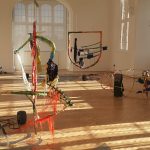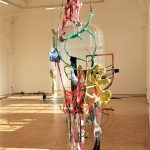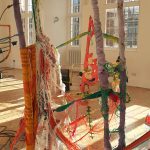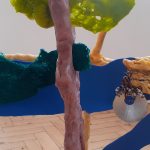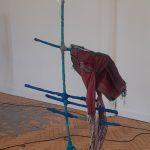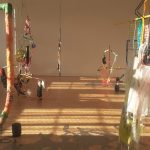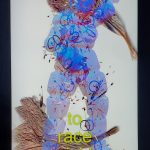London calling | chapter 3
Julien Creuzet
Too blue, too deep, too dark we sank, meandering every moving limb. In the den, in the womb.
Too bèlè, too gwo-ka, too beguine, too compass, too kadans, too calypso, too mazurka, too makossa, in my joyful sadness (…)
ITA (English below)
Con una installazione che comprende scultura, musica, video e poesia, l’artista Julien Creuzet affronta le relazioni e le dinamiche socio-culturali tra i paesi caraibici e l’Europa. Il lavoro di Creuzet guarda agli sviluppi e alle conseguenze del colonialismo europeo, chiamando in causa l’universalismo creato da esso.
Le coloratissime sculture sospese dall’alto soffitto; i fogli di lamiera scolpiti che ricoprono grandi porzioni di pavimento; i suoni e le musiche provenienti sia dagli speaker che dai video; le parole, quelle udite, quelle lette, quelle suggerite. Per la sua prima mostra istituzionale nel Regno Unito, l’artista franco-caraibico Julien Creuzet (1986) presenta al Camden Art Centre di Londra una installazione che richiama e analizza la propria esperienza e quella riguardante la diaspora caraibica, richiamando in causa gli aspetti politici e sociali della questione.
Nato in Francia, Creuzet mette al centro della propria ricerca artistica il paese natale dei genitori e nel quale è cresciuto, la Martinica, paese che tutt’oggi è sotto la giurisdizione francese; per l’artista, la Martinica è, “the heart of my imagination” (il cuore della mia immaginazione), il punto focale della sua riflessione, la quale abbraccia il passato, il presente e il futuro della diaspora caraibica. Il lavoro di Creuzet è dichiaramente influenzato dalle idee di autori come Aimè Cesaire, Edouard Glissant e Léopold Sédar Senghor, figure rilevanti all’interno dei movimenti filosofico-letterari quali la negritudine e la creolizzazione; gli scritti di questi autori, se da un lato criticano apertamente il pensiero dominante occidentale, dall’altro rivendicano la unicità e la complessità della cultura caraibica.
Partendo da queste posizioni, l’artista esplora e interroga l’intricata relazione tra i paesi caraibici e i paesi Europei colonizzatori, ma anche tra le isole caraibiche stesse; l’installazione di Creuzet invita a distinguere i confini politici, imposti dai colonizzatori, i quali dividono le isole caraibiche secondo le lingue parlate, le valute e l’economia, da quelli geografici (in questo caso, uno, cioè il mare), i quali avvicinano le isole caraibiche e aiutano a capire le connessioni socio-culturali tra esse; come afferma l’artista stesso: “These are places that share the same music, the same food” (questi sono luoghi che condividono la stessa musica, lo stesso cibo).
L’installazione di Creuzet si concentra in due diverse sale del Camden Art Centre: nella sala più grande, e all’esterno di essa, si trovano le sgargianti sculture assemblate con vari oggetti trovati o ricevuti da altri artisti (plastica, tessuti vari, cavi elettrici, bottiglie, pezzi di giornali). Sul pavimento si distendono diversi fogli di metallo, tagliati mediante laser, sui quali è possible camminare; degli speaker sono posti attraverso la stanza, dai quali provengono musica e suoni composti dall’artista in collaborazione con la cantante franco-senegalese anaiis.
In aggiunta, due video completano l’installazione: nel video che si trova nella stanza principale, un personaggio animato, composto da vari oggetti che fluttuano all’interno e all’esterno del suo corpo transparente (tra gli oggetti: smartphone, frutta, navi, sigarette), mostra, ad uno a uno, dei libri di autori caraibici e non che riguardano questioni post-coloniali; nell’altro, lo stesso personaggio, è intento a ballare la bèlè, una danza tradizionale della Martinica generalmente collegata a momenti di dolore (effettuata durante funerali), ma che acquista anche un forte significato come simbolo di identità.
Tutte le sculture sembrano trovarsi in uno spazio a metà tra il figurativo e l’astratto; esse richiamano e sviluppano simboli (alcuni ripresi anche nelle diverse bandiere dei paesi caraibici), che spesso riprendono la flora e la fauna del luogo. Allo stesso modo, i fogli metallici riprendono simboli naturali, come il fiore nazionale delle Barbados, ma anche rappresentazioni legate alla storia coloniale, come la riproduzione di un diagramma del viaggio di una nave Britannica, con chiaro riferimento al middle passage e alla tratta degli schiavi.
Nell’assemblaggio di Creuzet, i diversi linguaggi artistici si intrecciano l’uno con l’altro, riprendendo un metodo che l’artista ha utilizzato in passato: “I believe in the permeation of all disciplines to enable us to expand our repertoire of forms” (credo nella permeabilità di tutte le discipline per permetterci di espandere il nostro repertorio di forme). In “too blue, too deep, too dark we sank”, Creuzet presenta le opere in una relazione in costante divenire, mai statica (le stesse sculture, al passare dei visitatori, si muovono e ondeggiano lentamente); seguendo questa metodologia, l’artista ribadisce la necessità di accostarsi alla cultura caraibica andando oltre i confini imposti dall’esperienza coloniale.
Quello di Creuzet è un atto politico di liberazione che mette sotto accusa l’universalismo creato dal pensiero coloniale-occidentale cercando nuove soluzioni e diversi punti di osservazione; pertanto, la sfida all’universalismo occidentale è esplicitamente lanciata non solo attraverso le opere (in particolar modo nel video che riprende la danza, sul quale compaiono scritte quali “to economic distress”, “to mental paralysis”), ma anche attraverso la metodologia con il quale le opere sono assemblate e presentate.
A tal riguardo, un ultimo esempio comprende i titoli delle opere, i quali vanno da poemi a lunghe domande scritte in diverse lingue (inglese, francese, spagnolo): tanto quanto le opere, anche i titoli sfidano nozioni imposte di certezza e sicurezza, asserendo la necessità di avere un pensiero critico libero dalla determinatezza dell’universalismo occidentale.
* * *
ENG
With an installation that includes sculpture, music, video and poetry, the artist Julien Creuzet tackles the relationships and socio-cultural dynamics between Caribbean countries and Europe. Creuzet’s work looks at the developments and consequences of European colonialism, calling into question the universalism created by it.
The colourful sculptures suspended from the high ceiling; the laser-cut metal sheets that cover large portions of the floor; the sounds and music coming from the speakers and the videos; the words, those heard, those read, those suggested. For his first institutional exhibition in the United Kingdom, the Franco-Caribbean artist Julien Creuzet (1986) presents an installation at London Camden Art Centre that recalls and explores his own experience and that of the Caribbean diaspora, calling into question the political and social aspects of the matter.
Born in France, Creuzet places at the centre of his research his parents’ native-land and the country where he grew up, Martinique, which is still under French jurisdiction today; for the artist, Martinique is “the heart of my imagination”, the focal point of his reflection, which embraces the past, present and future of the Caribbean diaspora. Creuzet’s work is overtly influenced by the ideas of authors such as Aimè Cesaire, Edouard Glissant and Léopold Sédar Senghor, relevant figures within the philosophical-literary movements such as Negritude and Creolization; the writings of these authors, if on the one hand boldly criticize the dominant Western positions, on the other they claim the uniqueness and complexity of Caribbean culture.
Starting from these notions, the artist explores and questions the intricate relationship between Caribbean countries and colonizing European countries, but also between the Caribbean islands themselves; Creuzet’s installation invites us to distinguish the political borders, enforced by the colonisers, that divide the Caribbean islands according to the languages spoken, the currencies and the economy, from the geographical ones (in this case, one, that is the sea), which bring the Caribbean islands closer together and help to understand the socio-cultural connections between them; as the artist himself states: “These are places that share the same music, the same food”.
Creuzet’s installation is concentrated in two different rooms of Camden Art Centre: in the largest room, and outside it, there are the gaudy sculptures assembled with various objects found or received by other artists (plastic, various fabrics, electric wires, bottles, pieces of newspapers). On the floor there are several laser-cut metal sheets on which it is possible to walk; speakers are placed across the room, from which come music and sounds composed by the artist in collaboration with the Franco-Senegalese singer anaiis.
In addition, two videos complete the installation: in the one located in the main room, an animated character, composed of various objects that float inside and outside his transparent body (among the objects: smartphone, fruit, ships, cigarettes ), shows, one by one, books by Caribbean and non-Caribbean authors that deal with post-colonial issues; in the other, the same character is intent on dancing the bèlè, a traditional Martinican dance generally connected to moments of grief (performed during funerals), but which also acquires a strong meaning as a symbol of identity.
All the sculptures seem to be in a space halfway between the figurative and the abstract; they recall and develop symbols (some also taken up in the various flags of the Caribbean countries), which often reflect the flora and fauna of those countries. Similarly, the metal sheets take up natural symbols, such as the national flower of Barbados, but also representations linked to colonial history, such as the reproduction of a diagram of the voyage of a British ship, with clear reference to the middle passage and the slave trade.
In Creuzet’s installation, the different artistic languages intertwine with each other, taking up a method that the artist used in the past: “I believe in the permeation of all disciplines to enable us to expand our repertoire of forms”. In “too blue, too deep, too dark we sank”, Creuzet presents the works in a constantly evolving, never static relationship (the same sculptures, as visitors pass, move and sway slowly); following this methodology, the artist reiterates the need to approach Caribbean culture by going beyond the boundaries imposed by the colonial experience.
Creuzet’s work is a political act of liberation that puts the universalism created by colonial-Western culture under accusation, seeking new solutions and diverse observation points; therefore, the challenge to Western universalism is explicitly launched not only through the works (especially in the video that takes up the dance, on which there are writings such as “to economic distress”, “to mental paralysis”), but also through the methodology with the which the works are assembled and displayed.
In this regard, a final example includes the titles of the works, which range from poems to long questions written in different languages (English, French, Spanish): as much as the works, the titles also challenge imposed notions of certainty and security, asserting the need to have a critical thinking free from the determination of Western universalism.

